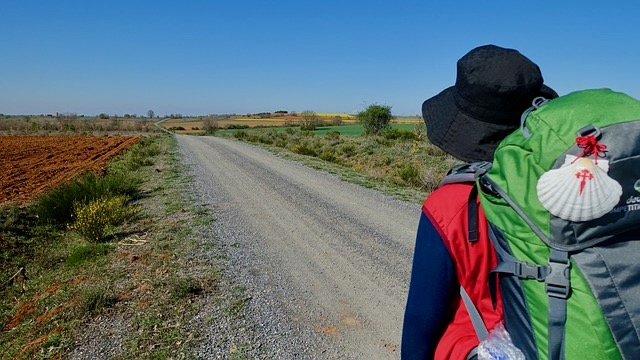Imagine setting off on a journey where every step brings you closer to not just a destination, but a deeper understanding of yourself. That’s the magic of the Camino de Santiago, particularly when you take on this adventure solo.
The Camino, also known as The Way of St. James, is a network of ancient pilgrim routes that converge at the tomb of St. James in Santiago de Compostela, Spain. While there are many ways to experience this historic trek, doing it alone offers a unique and deeply personal experience.

The Allure of Going Solo
Why go solo, you might ask? There’s a certain freedom in walking the Camino on your own. You’re not bound by anyone else’s schedule or pace. You can start your day when the sun rises, or take a leisurely morning and hit the trail when you’re ready. This flexibility allows you to fully immerse yourself in the experience, taking in the sights, sounds, and smells of the beautiful landscapes you traverse.
Walking solo also offers a chance for introspection. Without the distraction of constant conversation, you have the opportunity to reflect on your life, your goals, and your dreams. The Camino has a way of bringing clarity and insight, helping you reconnect with yourself in ways you might not expect.

Historical and Spiritual Significance
The Camino de Santiago isn’t just a hike; it’s a pilgrimage with deep historical and spiritual roots. The most popular route, the Camino Francés, stretches approximately 780 kilometres from St. Jean Pied de Port in France to Santiago de Compostela. This path has been walked by pilgrims for over a thousand years, each one adding their own story to the rich tapestry of the Camino.
Walking these ancient paths, you can’t help but feel a connection to the countless pilgrims who have come before you. The journey is steeped in history, with medieval churches, ancient bridges, and quaint villages that seem frozen in time. Each step brings you closer to Santiago, but also deeper into the rich history of the region.

Practical Tips for Solo Pilgrims
- Preparation is Key: While the idea of setting off on a spontaneous adventure is romantic, a bit of preparation can go a long way. Invest in good-quality hiking boots and break them in before your trip. A well-packed backpack with essentials like a first-aid kit, water bottle, and layers for varying weather will make your journey more comfortable.
- Accommodation: One of the joys of the Camino is the camaraderie among pilgrims. You’ll find plenty of albergues (pilgrim hostels) along the way, offering a place to rest and connect with fellow travellers. Booking in advance isn’t always necessary, but during peak season (April to October), it’s wise to have a general plan.
- Safety: Walking solo does come with its own set of risks, but the Camino is generally very safe. Stick to the well-marked paths, let someone know your plans each day, and trust your instincts. Most pilgrims find the local communities welcoming and helpful.

Embracing the Journey
The Camino de Santiago is as much about the journey as it is about the destination. Walking solo, you have the freedom to set your own pace and take detours that catch your interest. Perhaps you’ll find yourself lingering in the vibrant city of Pamplona, famous for its Running of the Bulls, or exploring the Gothic architecture of Burgos Cathedral.
You’ll pass through the stunning landscapes of northern Spain, from the rolling vineyards of La Rioja to the rugged beauty of Galicia. Each region has its own distinct character and charm, offering a constantly changing backdrop to your journey.

The People You Meet
One of the unexpected joys of the Camino is the people you meet along the way. Fellow pilgrims from all over the world, each with their own stories and motivations for walking. While you’re walking solo, you’re never truly alone. There’s a sense of community among pilgrims that’s hard to describe until you’ve experienced it. Shared meals, stories, and sometimes even tears create bonds that last long after the journey ends.

A Personal Transformation
Many solo pilgrims find that the Camino de Santiago is a transformative experience. The physical challenge of walking long distances day after day, combined with the time for reflection, can lead to profound personal insights.
Some people walk the Camino as a form of spiritual retreat, others for the physical challenge, and some simply for the adventure. Whatever your reasons, the journey has a way of revealing things about yourself that you might not have discovered otherwise.

Camino de Santiago Tours
For those who prefer a bit more structure or companionship, Camino de Santiago tours offer an excellent alternative to going completely solo. These tours can range from guided group walks to self-guided packages that take care of logistics such as accommodation, meals, and luggage transport.
They offer the convenience of having a planned itinerary while still allowing for personal reflection and exploration. Guided tours often include knowledgeable guides who provide insights into the history and culture of the regions you pass through, enhancing your experience.
Self-guided tours, on the other hand, provide the support and structure you might need, without the presence of a guide, giving you the best of both worlds: the independence of walking alone and the reassurance that everything is taken care of.

Practical Advice for the Journey
- Stay Hydrated and Nourished: The physical demands of walking the Camino mean you need to take care of your body. Carry plenty of water and snacks, and take regular breaks to rest and refuel.
- Listen to Your Body: It’s important to pay attention to your body’s signals. Blisters, aches, and fatigue are common, especially in the early days. Don’t push yourself too hard; remember, it’s a marathon, not a sprint.
- Keep an Open Mind: The Camino is unpredictable. You might encounter bad weather, closed albergues, or other unexpected challenges. Embrace these moments as part of the journey and stay flexible.

The Final Steps
Reaching Santiago de Compostela is a moment of triumph and reflection. Standing in front of the magnificent cathedral, knowing that you’ve walked hundreds of kilometres to get there, is an indescribable feeling. Many pilgrims attend the Pilgrim’s Mass, held daily at the cathedral, which is a beautiful way to mark the end of your journey.
Walking the Camino de Santiago solo is more than just a physical journey; it’s an opportunity for personal growth and self-discovery. It’s a chance to step away from the hustle and bustle of everyday life and reconnect with yourself and the world around you. So, lace up your boots, pack your backpack, and set off on an adventure that will stay with you long after the final step.

